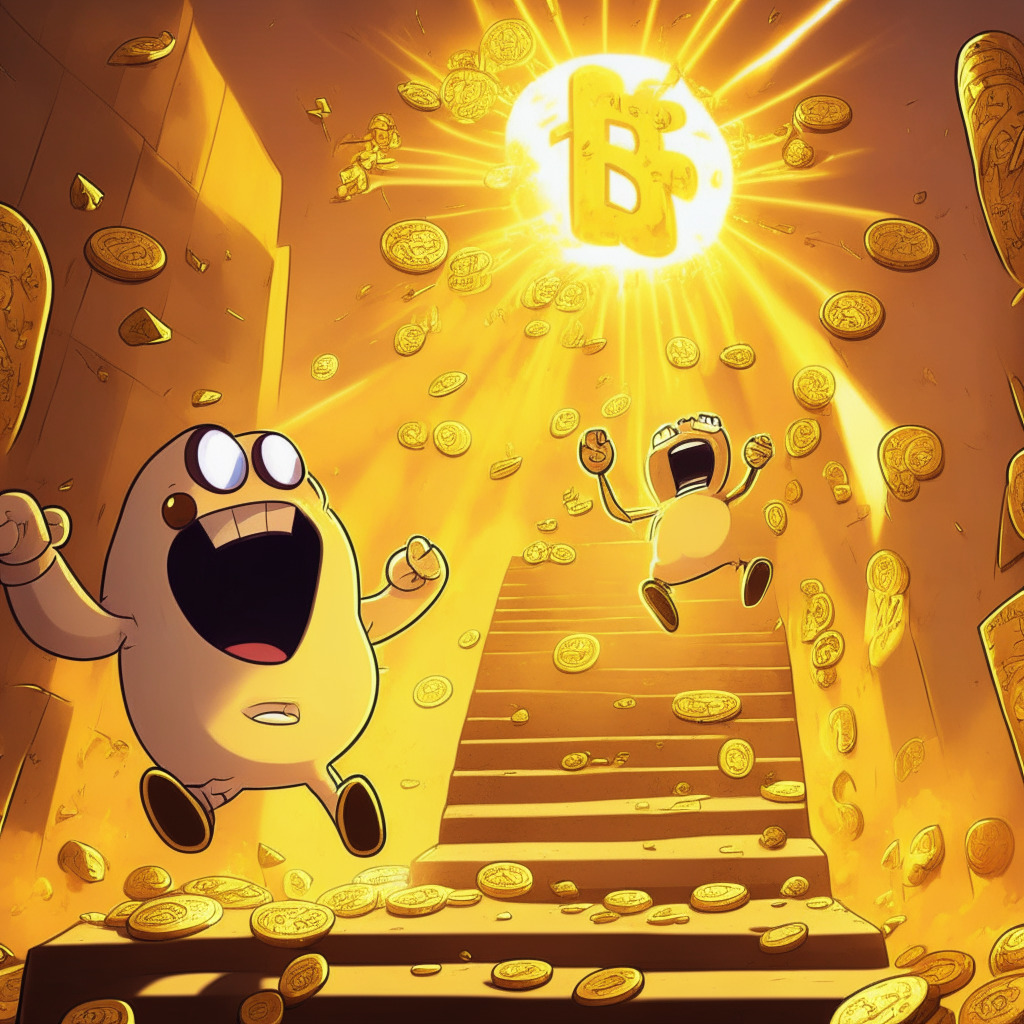The article discusses the importance of assessing layer-1 blockchains profitability using a Years-to-Profitability (YTP) ratio method. It highlights the role of emissions schedule and tokenomics in projecting future costs. Furthermore, the article stresses the value of YTP as a tool in measuring a blockchain’s profitability and sustainability, particularly in relation to burn mechanisms and supply dynamics.
Search Results for: Coin Metrics
Bitcoin Bulls vs $30,000 Support: Analyzing Traders’ Positions Amid Crypto Gains and Regulations
Bitcoin bulls have leveraged long positions using margin and futures markets, backed by positive momentum from spot Bitcoin ETF requests, heavy institutional inflow, and improved U.S. regulatory perspectives. This support helps sustain the $30,000 BTC price level in the coming weeks.
Bitcoin at $33,000: Tipping Point for Speculative Selling or Market Recovery?
Market researchers warn that Bitcoin speculators may sell if the price surpasses $33,000, potentially causing a market correction. Key indicators like MVRV and SOPR suggest short-term holder profit-taking risk and seller exhaustion, making $33,000 a critical level for investors to watch.
Binance Layoffs Amid SEC Lawsuit, Coinbase Losing Ground to Robinhood: Balancing Regulation and Growth
Binance.US faces a lawsuit by the US SEC, leading to layoffs primarily in legal, compliance, and risks departments. The crypto market experiences challenges amid increasing regulatory scrutiny, as retail crypto trading allegedly shifts from Coinbase to Robinhood, raising concerns about market stability.
FOMC Meeting Impact on Bitcoin: Price Predictions and Breakout Opportunities
Traders and investors await the upcoming FOMC meeting and Fed Rate announcement, which can significantly impact the cryptocurrency market, particularly Bitcoin and Ethereum. Recent analysis introduces an innovative method to examine the Bitcoin network’s hash power using nonce patterns, while the leading cryptocurrency faces resistance at the $26,250 level and finds support around $25,500.
Decoding Bitcoin’s Energy Use: New Method for Accurate Estimations and E-Waste Impact
The Coin Metrics report examines Bitcoin miners’ energy consumption by analyzing blockchain data, offering more accurate estimates compared to previous studies. Incorporating hardware efficiency and e-waste, it facilitates more robust, data-driven discussions about Bitcoin’s environmental impact and future decision-making in crypto mining.
Bitmain Mining Rigs Claim 76% of Bitcoin’s Hashrate: Decentralization & Energy Efficiency Debate
Recent research by Coinmetrics reveals that three Bitmain mining rig models hold a 76% share of Bitcoin network computing power, highlighting energy efficiency’s role in modern mining. The report also shows a 60% improvement in the network’s energy efficiency since July 2018, with 33.6 joules per terahash consumed today compared to 89.3 J/TH in 2018.
Bitcoin’s Struggle at $27,000: Regulatory Scrutiny and Global Economic Crisis Impact
Bitcoin price nears $27,000 but faces challenges from stricter regulatory scrutiny following FTX’s bankruptcy and a global economic crisis. Bitcoin derivatives markets indicate low probability of breaking above $27,500, suggesting a bearish market structure and a likely $25,500 support retest.
Ethereum’s Future Amid Binance and Coinbase Scrutiny: Pros, Cons, and Potential Conflicts
Ethereum faces a challenging week amid the US SEC’s charges against Binance and Coinbase for securities violations. Bloomberg Intelligence’s Mike McGlone discusses Ethereum’s growth obstacles, including diminishing supply, low demand, and potential regulatory scrutiny following its Proof-of-Stake Merge event.
SEC Crackdown Effects on Crypto Volatility: Analyzing Market Reactions and Altcoin Impact
The SEC’s crackdown on Binance and Coinbase hasn’t significantly impacted Bitcoin’s options-based implied volatility metrics, as traders anticipated and accounted for the lawsuits. The recent actions primarily affect altcoins, while consequences on the value and performance of major cryptocurrencies, such as BTC and ETH, remain relatively minimal.
Lightning Index Rate (LINER): A Game Changer for Enterprise Adoption of Bitcoin’s Network?
Amboss introduces the Lightning Index Rate (LINER) to attract enterprises to Bitcoin’s Lightning Network by offering insights into cost and yield comparisons with traditional financial institutions. The index eliminates credit risk and provides cost advantages over legacy systems, potentially incentivizing businesses to switch to Lightning Network usage.
Pepe Coin’s Uncertain Future: Potential Rebound or Continuous Decline?
Pepe Coin price gained 1% in the past 24 hours despite recent declines, with some indicators pointing to renewed growth potential. However, it remains a meme token lacking practical utility. Alternatives like presale tokens, such as ECOTERRA, provide similar opportunities for potential gains.
Exiting Capitulation: New Metric Hints at Bright Future for Bitcoin Hodlers
Bitcoin hodlers exit the capitulation phase, as analytics firm Glassnode unveils its “Long Term Holder Spending & Profitability” tool in their newsletter, “The Week On-Chain.” The new metric reveals a change in sentiment among long-term BTC holders, hinting at a brighter future for cryptocurrency.
Bitcoin’s Struggle to Retain $28,000: Market Forces and Growth Potential Explored
Bitcoin’s recent recovery is influenced by the broader market’s gravity, and its sustained growth relies on cyclical trends in long-term supply. Glassnode’s report suggests long-term holders remain consistent in buying habits, and Bitcoin’s growth shows a strong correlation with the mainstream stock market.
Cardano Summer: Will ADA Surpass Bitcoin and Ethereum amid Regulatory Changes?
Cardano founder Charles Hoskinson envisions a bright future for the proof-of-stake blockchain platform, with potential to surpass Bitcoin and Ethereum due to upcoming updates and proposals like CIP-1694. Hoskinson also discussed metrics for decentralization and the importance of a nuanced regulatory framework in the wake of recent SEC actions against the crypto industry.
Canaan Battles Market Turbulence: Financial Metrics Show Signs of Recovery Amid Challenges
Bitcoin mining company Canaan reported improvements in financial metrics during Q1 2023 amid market turbulence, with a net loss of $84.4 million. Despite reduced revenues and investment in research and development, Canaan’s operating losses reduced by 31.4% and income from mining activities rose 3.3% from Q4 2022.
Green Proofs of Bitcoin: A Step Towards Sustainable Crypto Mining and Transparency
Energy Web has launched the Green Proofs of Bitcoin (GP4BTC) registry, aiming to address environmental concerns by tracking miners’ energy inputs and their impact on electric grids. The registry evaluates miners on renewable energy credit purchases and participation in demand response programs, promoting transparency in their energy sources and supporting a greener crypto industry.
Bitcoin Breakout at $29,000: Analyzing Joe Biden’s Crypto Tax Remarks and Market Factors
Analyst Marcel Pechman discusses Bitcoin’s stagnation around $27,000, attributing it to macroeconomic factors. He explores the possibility of a breakout towards $29,000 but highlights less probable bullish gains due to current futures premium and options risk metrics.
Bitcoin’s Bullish Breakout Amid US Debt Ceiling Standoff and Inflation Fears
Despite ongoing market uncertainties, Bitcoin margin and futures markets indicate a potential bullish breakout, with its primary resistance level at $27,500. Global inflationary pressures and the U.S. debt ceiling standoff may contribute to Bitcoin’s digital scarcity as an attractive alternative investment. Traders maintain a cautiously bullish stance as Bitcoin’s market structure appears favorable.
Exploring the New Bitcoin Speculation Cycle: RHODL Ratio and Its Impact on Bull Runs
Bitcoin seems to be entering a new “speculation cycle,” indicating a potential bull run, as revealed by RHODL Ratio metric analysis by Philip Swift, creator of LookIntoBitcoin. This method tracks BTC price behavior based on realized price of the supply and provides insight into market speculation.
Bitcoin Price Correction: Analyzing Futures, Options & Potential Comeback to $28,000
Bitcoin experienced an eight-day decline, resulting in a 9.4% correction, as it faced network congestion and increased transaction fees. Despite challenges and uncertainty surrounding regulatory changes, BTC derivatives metrics haven’t turned bearish, leaving room for a potential price rally.
AI’s ChatGPT Meets Crypto: Worldcoin, Iris Scanning, and Future Challenges
OpenAI’s Sam Altman is eyeing the crypto industry with Worldcoin, a globally-disruptive cryptocurrency using iris-scanning technology for secure identification. Amidst regulatory action and concerns surrounding user privacy, Worldcoin aims to reimagine transactions and identity verification while building trust in its security measures.
Bitcoin’s Price Dip: Puell Multiple Suggests Bearish Outlook or Temporary Blip?
Bitcoin price saw a brief dip below the 200-week moving average before rebounding, but on-chain data like the Puell Multiple indicate a bearish outlook, suggesting investors should consider booking profits. Factors affecting BTC prices include macroeconomic forces, false sell-off reports, and high transaction fees. It’s crucial for investors to conduct thorough research before making decisions to avoid unexpected losses.
Bitcoin’s Future at $25,000: Factors Influencing Market Sentiment and Key Price Levels
As Bitcoin nears the $25,000 support level, its future trajectory is uncertain due to factors like increased regulatory scrutiny, concerns around the Grayscale GBTC Trust Fund, and the strong US dollar. Technical indicators suggest a potential bullish rebound if Bitcoin stays above $26,000, but challenges remain.
Bitcoin Price Drop: Regulatory Uncertainty and Resilient Traders Battle for $28,000
The Bitcoin price dropped 7% on May 12, breaking below the 55-day support and liquidating $100 million worth of long BTC futures contracts. Possible causes for the decline include increased regulatory uncertainty in the U.S., concerns over Grayscale GBTC Trust Fund holdings, and the Dollar Strength Index. Despite this drop, derivative market metrics and trader stances indicate hope for a recovery towards $28,000.
BRC-20 Tokens Boom: Impact on Bitcoin’s Network, Fees, and Future Prospects
The increasing popularity of BRC-20 tokens, a new Bitcoin blockchain-based fungible token standard, is causing significant changes in the Bitcoin network, but also leading to a sharp rise in transaction fees, negatively impacting Bitcoin sentiment.
Crypto Clash: Memecoin Mania, NFT Downturn, and Mining Stocks Outshine Bitcoin
In April, memecoins’ rise led to a decline in NFT collectibles, with key metrics such as volume and active wallets plunging. However, the NFT lending market experienced a 16.13% increase in new users, indicating consistent growth in this niche sector. Cryptocurrency mining stocks also performed impressively, outperforming Bitcoin’s returns.
Bitcoin Stagnation: Examining Market Sentiments Amid Macroeconomic Concerns
Bitcoin price has recently remained within an 8.5% range, causing a drop in the 40-day volatility metric. Investors are losing their risk appetite due to factors like recession concerns and the U.S. debt ceiling issue. Bitcoin futures and options data suggest traders lack confidence, leaning towards sideways trading. This multifaceted environment may have driven investors towards fixed-income trades with higher interest rates.
Meme Coin Showdown: $SPONGE Surpasses Pepe in Record Time, What’s Next?
The meme coin $SPONGE is gaining momentum, securing a market cap of $27 million just three days after launching on decentralized exchanges. Surpassing Pepe in speed, $SPONGE is now listed on LBank and rumors suggest a possible Binance listing. However, investors should exercise caution due to potential volatility in meme coin markets.
Binance Outages, High Fees, and Volatility: Dissecting Bitcoin’s Turbulent Week
A turbulent week for Bitcoin, marked by high transaction fees, Binance withdrawal outages, and miner sell-offs, has created uncertainty in the BTC/USD market. Despite concerns of an unsustainable bubble, industry experts maintain optimism while monitoring the impact of upcoming macroeconomic data releases.
Cardano’s Future: Bulls vs Bears, On-chain Metrics and Diversifying with Presale Tokens
Cardano (ADA) stays in this week’s $0.38-$0.40ish range, as on-chain metrics show strength in the network. Despite being down 87% from its 2021 peaks, ADA’s ecosystem hosts high development and Decentralized Finance projects, attracting large investments. Diversification with emerging projects like Ecoterra offers a balanced, high-reward investment strategy for crypto enthusiasts.
Ethereum’s Meme Coin Mania: Surge in Demand vs. Rising Transaction Costs
Ethereum’s transaction fees hit a 12-month high due to meme coin mania, with the pepecoin launch contributing significantly to network demand. Though meme coins generate substantial attention and market value, they also exhibit high volatility and cause unpredictability in network demand and transaction cost fluctuations for Ethereum.































